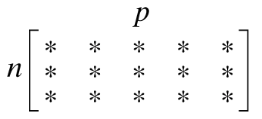Linear Equations in Linear Algebra
1.7 Linear Independence
Linear Independence
Definition : Linear Independence
An indexed set of vectors in is said to be linearly independent if the vector equation
has only the trivial solution (=only zero vector can be ).
That is, the set is said to be linearly dependent if there exist weights , not all zero, such that
- Equation (2) is called a linear dependence relation among when the weights are not all zero.
- An indexed set is linearly dependent if and only if it is not linearly independent.
Practical Definition : Linear Independence
Given a set of vectors in ,
check if can be represented as a linear combination of the previous vectors of the set for , e.g.,
- If at least one such is found, then is linearly dependent.
- If no such is found, then is linearly independent.
Example 1
Let , and .
- Determine if the set is linearly independent.
- If possible, find a linear dependence relation among , , and .
Solution of Example 1:
1.
We must determine if there is a nontrivial solution of the equation (1).
- Row operations on the associated augmented matrix show that
- and are basic variables, and is free.
- Each nonzero value of determines a nontrivial solution.
- , , are linearly dependent.
2.
To find a linear dependence relation among , , and completely row reduce the augmented matrix and write the new system:
- Thus and and is free.
- Choose nonzero value for , e.g., .
- Then and .
- Substitute these values into equation (1) and obtain the equation below.
- This is one (out of infinitely many) possible linear dependence relations among , , and .
Linear Independence of Matrix Columns
Suppose that we begin with a matrix instead of a set of vectors.
The matrix equation can be written as
Each linear dependence relation among the columns of corresponds to a nontrivial solution of
The columns of matrix are linearly independent if and only if the equation has only the trivial solution.
Sets of One or Two Vectors
A set containing only one vector – say, – is linearly independent if and only if is not the zero vector.
This is because the vector equation has only the trivial solution when .
The zero vector is linearly dependent because has many nontrivial solutions.
A set of two vectors is linearly dependent if at least one of the vectors is a multiple of the other.
The set is linearly independent if and only if neither of the vectors is a multiple of the other.
Sets of Two or More Vectors
Theorem 7 : Characterization of Linearly Dependent Sets
An indexed set of two or more vectors is linearly dependent if and only if at least one of the vectors in is a linear combination of the others. In fact, if is linearly dependent and then some (with ) is a linear combination of the preceding vectors, .
Theorem 7 does not say that every vector in a linearly dependent set is a linear combination of the preceding vectors.
A vector in a linearly dependent set may fail to be a linear combination of the other vectors.
Proof of Theorem 7:
If some in equals a linear combination of the other vectors,then can be subtracted from both sides of the equation, producing a linear dependence relation with a nonzero weight (−1) on
e.g., if , then .
Thus is linearly dependent.
Conversely, suppose is linearly dependent.
If is zero, then it is a (trivial) linear combination of the other vectors in .
즉, zero vector를 포함한 경우, 해당 집합은 항상 linearly dependent가 된다. zero vector의 coef.는 무엇이든지간에 0이 되기 때문임.
Otherwise, and there exist weights , not all zero, such that .
Let be the largest subscript for which .
If then , which is impossible because .
(인 경우, 1보다 큰 들은 모두 0이되어야 함. 즉, 나머지 coef들은 모조리 0이므로 남는 건 항 뿐으로 가 되어야 하는데 이는 불가능함.)
So
And
Example 4
Let and .
Describe the set spanned by and , and explain why a vector is in Span if and only if is linearly dependent.
Solution of Example 4:
The vectors and are linearly independent because neither vector is a multiple of the other, and so they span a plane in .
Span is the -plane with .
If is a linear combination of and , then is linearly dependent, by Theorem 7.
Conversely, suppose that is linearly dependent.
By Theorem 7, some vector in is a linear combination of the preceding vectors since .
That vector must be , since is not a multiple of .
So is in Span . Fig.2 below

Example 4 generalizes to any set in with and linearly independent.
The set will be linearly dependent if and only if is in the plane spanned by and .
Theorem 8
If a set contains more vectors than there are entries in each vector, then the set is linearly dependent. That is, any set is linearly dependent if .
Proof
Let .
Then is , and the equation corresponds to a system of equation in unknowns.
If , there are more variables than equations, so there must be a free variable.
Hence has a nontrivial solution, and the columns of is linearly dependent.
See the figure below for a matrix version of this theorem.

- if , the columns are linearly dependent.
- Theorem 8 says nothing about the case in which the number of vectors in the set does not exceed the number of entries in each vector.
Theorem 9
If a set contains the zero vector, then the set is linearly dependent.
Proof of Theorem 9
By renumbering the vectors, we may suppose .
Then the equation shows that is linearly dependent.